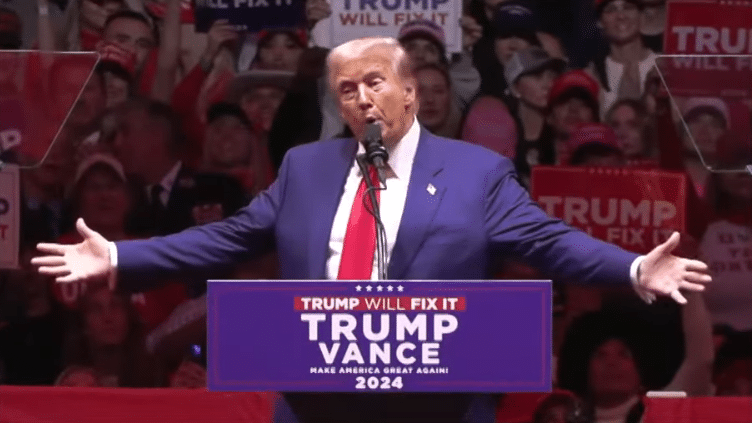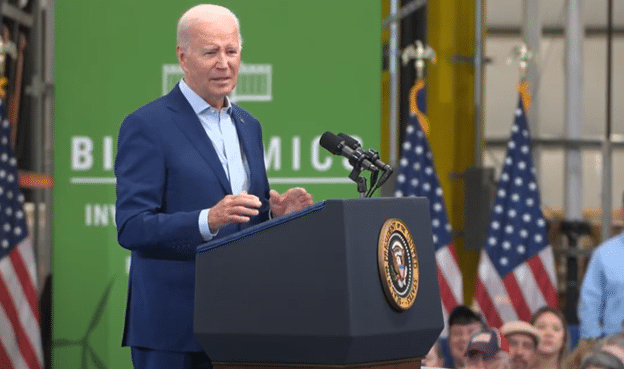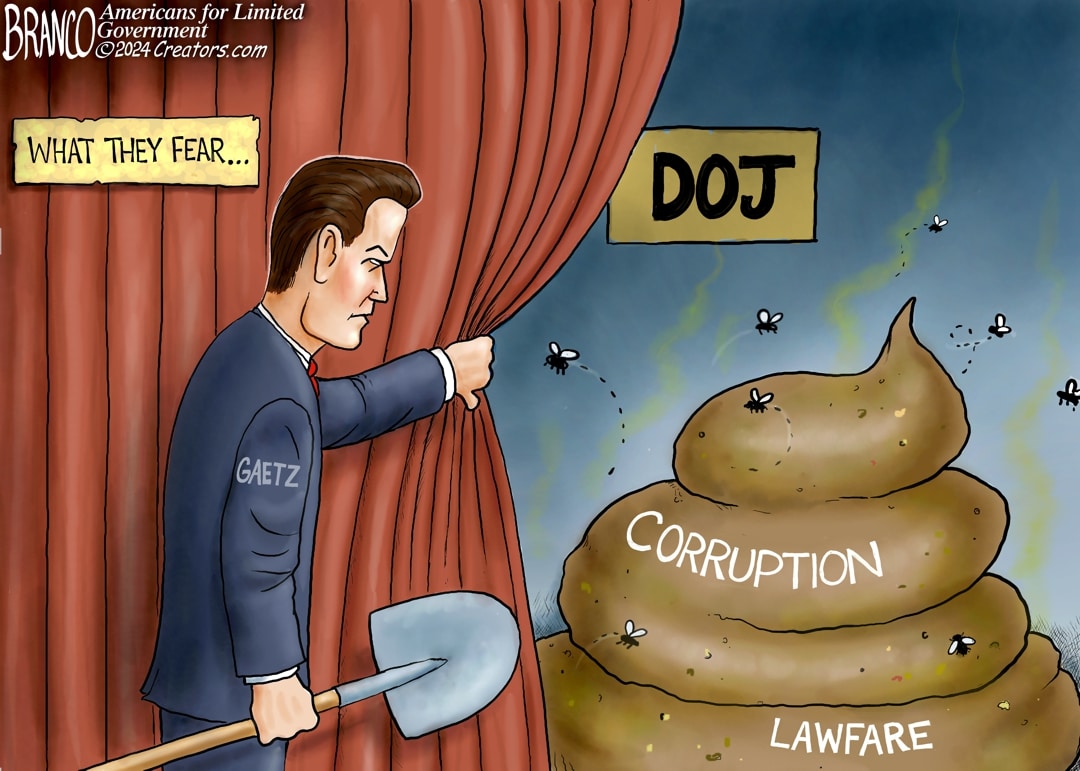Congress Needs To Act On Trump Agenda

November 18, 2024
Permission to republish original opeds and cartoons granted.
Make America Great Again Is More Than A Slogan—It Is Necessary
| 
|
|
For the first time since the reign of Franklin D. Roosevelt which put the full-throated administrative state in place, America has aligned the executive, legislative and judicial branches to restore power to the people and rip it out of the hands of their taxpayer funded overlords in the federal bureaucracy. This is the time, purpose and vision behind the founding of Americans for Limited Government more than twenty years ago. In the past three years, the Supreme Court has opened the door for the first time in decades to rollback federal regulatory overreach. The Court declared that regulations which go beyond the law passed by the elected Congress are unconstitutional in West Virginia v. EPA. And by ending so-called Chevron deference, the federal courts can listen to arguments and dismiss absurd or disputed claims by regulators when confronted with conflicting and credible testimony. These two cases, along with a few others that have the same effect, open the doors not only in the Courts, but for Congress to act to shut down this unconstitutional expansion of government. To make matters even more hopeful, President Donald Trump has appointed Elon Musk and Vivek Ramaswamy to head a non-governmental Department of Government Efficiency with the goal of streamlining government and providing the President and Congress a pathway to not only wring waste, fraud and abuse out of the system, but to provide a blueprint on government reorganization. These are hopeful times, but here is the secret that we all know. If changes are simply made using Donald Trump’s formidable pen and paper, they can be rescinded as early as 2029. This is why Congressional action is essential. |
As sticky inflation ticked up to 2.6 percent in October, nagging issue that sank Biden-Harris highlights need for less spending, more production
| 
|
|
Don’t look now, but inflation over the past twelve months ticked upward from 2.4 percent in September to 2.6 percent in October following the Federal Reserve’s decision to begin cutting interest rates on Sept. 18 to 4.75 percent to 5 percent. The nagging inflation, which played a large role in defeating the incumbent Vice President Kamala Harris in the election, saw gasoline and oil ticking slightly downward in October — gas was down 0.9 percent and fuel oil was down 4.6 percent — but those might be getting a boost in November as the Ukraine war continues escalating in the twilight weeks of the Biden-Harris administration. Electricity was up another 1.2 percent in October, and is still up 4.5 percent the past year. Natural gas was up 0.3 percent, above trend for the past year of 2 percent. Food was up another 0.4 percent in October. Items less food and energy were up another 0.3 percent, and are up 3.3 percent the last twelve months. That was led by a 0.4 percent increase in transportation services, still up 8.2 percent the past year. Shelter was up another 0.4 percent as well, and is up 4.9 percent the past year. And medical care services were up 0.4 percent, up 3.8 percent the past year. So, what to do about it? Right now, the Federal Reserve appears to be postponing plans for further rate cuts
Congress can act to slow down spending increases, freezing or cutting the $1.9 trillion discretionary budget in the appropriations process, which can put less pressure on treasuries markets. And whatever is holding back agriculture and energy production, increasing supplies will decrease prices. Those are the options: Reduce the money supply and increase the availability of goods and services via fiscal policy and regulatory incentives — those are things the government can definitely influence.
|
Make America Great Again Is More Than A Slogan—It Is Necessary

By Rick Manning
For the first time since the reign of Franklin D. Roosevelt which put the full-throated administrative state in place, America has aligned the executive, legislative and judicial branches to restore power to the people and rip it out of the hands of their taxpayer funded overlords in the federal bureaucracy.
This is the time, purpose and vision behind the founding of Americans for Limited Government more than twenty years ago.
In the past three years, the Supreme Court has opened the door for the first time in decades to rollback federal regulatory overreach.
The Court declared that regulations which go beyond the law passed by the elected Congress are unconstitutional in West Virginia v. EPA.
And just this past year, the Court overturned a forty year old decision that instructed courts to give deference to the wisdom and knowledge of the federal bureaucracy over those who were suing to prevent the expansion of the regulatory state. By ending so-called Chevron deference, the federal courts can listen to arguments and dismiss absurd or disputed claims by regulators when confronted with conflicting and credible testimony.
These two cases, along with a few others that have the same effect, open the doors not only in the Courts, but for Congress to act to shut down this unconstitutional expansion of government.
To make matters even more hopeful, President Donald Trump has appointed Elon Musk and Vivek Ramaswamy to head a non-governmental Department of Government Efficiency with the goal of streamlining government and providing the President and Congress a pathway to not only wring waste, fraud and abuse out of the system, but to provide a blueprint on government reorganization.
These are hopeful times, but here is the secret that we all know. If changes are simply made using Donald Trump’s formidable pen and paper, they can be rescinded as early as 2029.
This is why Congressional action is essential. Narrow majorities in both the House and Senate will dictate some of the scope of change that can be made, but Congress can write regulations that overreach out of the law by refusing to reauthorize legislation unless the regulatory changes are made. They can strip funding for the implementation of these regulations through the appropriations process. And Congress can affirm Executive Branch recommended rescissions reflecting cuts in spending that have been deemed wasteful or unnecessary by the White House.
The great news is Speaker Mike Johnson (R-La.) and House Majority Leader Steve Scalise (R-La.) have already started the ball rolling by directing their Committee Chairs to identify these overreaching regulations so that the House can hit the ground running on day one.
The even better news is that with the bully pulpit of President Trump, media disruptors like Truth Social, talk radio and X.com and groups like Americans for Limited Government, the administrative state will face powerful grassroots pushback directly into Congress urging change.
The great restoration of America is possible. There are many, many challenges ahead, and it will likely take twelve years of GOP presidential leadership to clean up the mess created on a bipartisan basis over the past century.
But for the first time in generations, there is hope that the administrative state dragon can be slayed, spending can be refocused upon constitutional priorities and the great American economic engine will be unleashed to create a future that the Baby Boomer generation can’t imagine.
Freedom is contagious, and freeing the minds and talents of our nation’s entrepreneurs, inventors and dreamers has been the key to our nation’s wealth, historically creating a prosperous middle class where parents can achieve their dream that if their children apply themselves, they will achieve greater things than their parents.
Making America Great Again is not a slogan, it is a determination to fix what is broken in America including restoring individual freedom and today it is necessary and that is why there is hope unseen for generations.
Rick Manning is the President of Americans for Limited Government.
To view online: https://dailytorch.com/2024/11/make-america-great-again-is-more-than-a-slogan-it-is-necessary/
Cartoon: Shovel Ready Job

By A.F. Branco
Click here for a higher level resolution version.
To view online: https://dailytorch.com/2024/11/cartoon-shovel-ready-job/
As sticky inflation ticked up to 2.6 percent in October, nagging issue that sank Biden-Harris highlights need for less spending, more production

By Robert Romano
Don’t look now, but inflation over the past twelve months ticked upward from 2.4 percent in September to 2.6 percent in October following the Federal Reserve’s decision to begin cutting interest rates on Sept. 18 to 4.75 percent to 5 percent. Did the Fed start cutting too quickly?
Maybe, but the other side of that was the October employment report was really not good, showing tepid job creation by employers as the unemployment level ticked upward by 150,000, which is usually what happens during inflation cooling cycles after the economy has overheated and demand is exhausted.
So, right now, the U.S. economy is sending mixed signals, although sometimes you can see a final spike in inflation right before recessions like in 2008, 1991, 1981, 1980 and so forth.
The nagging inflation, which played a large role in defeating the incumbent Vice President Kamala Harris in the election, saw gasoline and oil ticking slightly downward in October — gas was down 0.9 percent and fuel oil was down 4.6 percent — but those might be getting a boost in November as the Ukraine war continues escalating in the twilight weeks of the Biden-Harris administration.
Electricity was up another 1.2 percent in October, and is still up 4.5 percent the past year.
Natural gas was up 0.3 percent, above trend for the past year of 2 percent.
Food was up another 0.4 percent in October.
Items less food and energy were up another 0.3 percent, and are up 3.3 percent the last twelve months.
That was led by a 0.4 percent increase in transportation services, still up 8.2 percent the past year.
Shelter was up another 0.4 percent as well, and is up 4.9 percent the past year.
And medical care services were up 0.4 percent, up 3.8 percent the past year.
So, what to do about it? Right now, the Federal Reserve appears to be postponing plans for further rate cuts, with Fed Chairman Jerome Powell stating Nov. 14, “The economy is not sending any signals that we need to be in a hurry to lower rates.”
Foreseeing interest rates elevated, which should soak up some more of the nearly $7 trillion printed, borrowed and spent into existence during and after Covid — the M2 money supply had decreased from $21.7 trillion in April 2022 to $20.7 trillion by Nov. 2023, but is up again $21.2 trillion as of Sept. 2024 — the other places to look will be fiscal policy and economic production.
Namely, Congress can act to slow down spending increases, freezing or cutting the $1.9 trillion discretionary budget in the appropriations process, which can put less pressure on treasuries markets.
That will certainly be a focus of the Republican Congress and President-elect Donald Trump — and his new Department of Government Efficiency headed by Elon Musk and Vivek Ramaswamy that is set to make recommendations to the White House Office of Management and Budget.
And whatever is holding back agriculture and energy production: regulations, bad mixes of incentives and subsidies for other items and deliberate production slowdowns by green do-gooders, need to be circumvented in some way. Whatever it is, increasing supplies will decrease prices.
Those are the options: Reduce the money supply and increase the availability of goods and services via fiscal policy and regulatory incentives — those are things the government can definitely influence.
There could also be an incidental recession, wherein unemployment increases, which can also have the impact of reducing demand and therefore inflation, which might actually speed the process up. On that count, even as Powell still aims for the elusive so-called “soft” landing, from Trump’s perspective, perhaps the sooner the better.
Historically, all of the largest bouts of inflation were ended by slowdowns and recessions.
Jimmy Carter had one in 1980 and it ended his presidency, and then Ronald Reagan had one in 1982 and by the time he was standing for another term, it was over and the recovery was fully underway, the high inflation did not return and he was reelected in a landslide. The lesson is to get it over with and take your medicine if necessary, and otherwise to create the best possible chance of success by creating less new money and boosting production.
Robert Romano is the Vice President of Public Policy at Americans for Limited Government Foundation.
To view online: https://dailytorch.com/2024/11/as-sticky-inflation-ticked-up-to-2-6-percent-in-october-nagging-issue-that-sank-biden-harris-highlights-need-for-less-spending-more-production/
